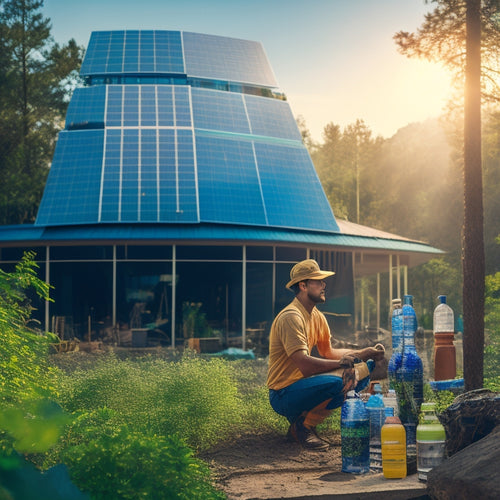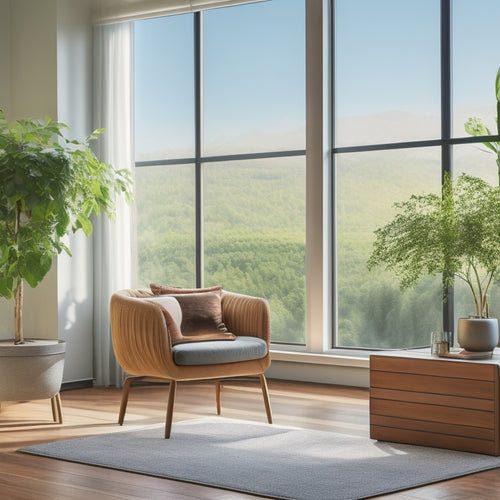
What Automated Shades Boost Building Energy Efficiency?
Share
By integrating automated shades into your building's design, you unveil a powerful tool that greatly reduces energy consumption and carbon emissions, optimizing your building's energy efficiency. They do this by minimizing reliance on artificial lighting, optimizing energy consumption, and reducing carbon footprint. Automated shades also enhance natural light harvesting, maximize daylighting strategies, and reduce HVAC energy consumption. As you investigate the benefits of automated shades, you'll realize how they can revolutionize your building's energy efficiency, leading to a more sustainable, cost-effective, and comfortable indoor environment - and that's just the beginning of the innovative possibilities.
Key Takeaways
- Automated shades significantly lower energy bills and carbon emissions by reducing reliance on artificial lighting and HVAC systems.
- Strategic shade positioning optimizes natural light, minimizing electric lighting usage and energy consumption by up to 75%.
- Automated shades block direct sunlight during peak hours, reducing cooling needs and preventing heat gain, thereby lowering HVAC energy consumption.
- Smart sensors and predictive algorithms in automated shades adjust temperature and lighting based on real-time data, ensuring optimal energy use and occupant comfort.
- Collaboration of automated shades with insulation systems optimizes energy retention, reduces heat loss, and maintains comfortable indoor temperatures.
Maximizing Natural Light Harvesting
As you gaze out the window, the morning sun casts a warm glow on your workspace, illuminating the tasks ahead. By utilizing natural light, you're not only reducing your energy consumption but also creating a more inviting atmosphere.
Furthermore, integrating solar-powered fast charging hubs in building design can further enhance energy efficiency. Automated shades optimize light quality, allowing you to fine-tune the amount of sunlight entering your space. This not only saves energy but also enhances the aesthetic appeal of your workspace.
Advanced Climate Control Systems
You've optimized your natural light intake, now it's time to fine-tune the internal climate. Advanced climate control systems take your building's energy efficiency to the next level.
Smart sensors and user interfaces work together to create a responsive environment, adjusting temperature and lighting levels based on real-time data. By leveraging renewable energy integration, building owners can reduce their reliance on the grid and carbon footprint.
Predictive algorithms analyze building analytics to anticipate and adapt to changing conditions, ensuring ideal energy use. With remote monitoring and energy dashboards, you can track performance and make data-driven decisions.
This fusion of technology and sustainability practices prioritizes occupant comfort while minimizing environmental impact. By embracing adaptive design, you're free to focus on what matters most – while your building works efficiently behind the scenes.
Energy Savings Through Automation
Beyond the domain of manual adjustments, automated shades emerge as a game-changing factor for energy efficiency. By automating your shades, you can optimize energy consumption and reduce your carbon footprint.
You can program your shades to adjust according to automated scheduling, guaranteeing that they're always in the right position to maximize natural light and minimize heat gain. Additionally, incorporating solar-powered charging stations into your building's infrastructure can further enhance energy independence and reduce fossil fuel dependence sustainable infrastructure.
-
Optimized Daylight Harvesting: Automated shades adjust to let in natural light during the day, reducing the need for artificial lighting.
-
Precise Temperature Control: Shades adjust to regulate heat gain and loss, reducing the load on your HVAC system.
-
Energy-Efficient Scheduling: Automated scheduling guarantees that shades are adjusted during off-peak hours to minimize energy consumption.
- Personalized User Preferences: You can program your shades to adjust according to your personal preferences, guaranteeing a comfortable and energy-efficient environment.
Smart Shade Integration Benefits
As you integrate automated shades with your building's systems, you'll access enhanced daylight harvesting capabilities that optimize natural light usage and reduce energy consumption.
By utilizing renewable energy sources, such as solar power, to power your building's systems, you can further minimize your carbon footprint.
You'll also experience seamless system syncing, where your shades work in harmony with lighting, HVAC, and security systems to create a truly optimized environment.
Enhanced Daylight Harvesting
With smart shade integration, your building's windows become a versatile gateway to utilizing natural light, reducing the need for artificial illumination and slashing energy costs in the process.
By exploiting the power of natural light, you can create a more sustainable and energy-efficient environment. This is achieved through:
-
Optimized daylighting: Automated shades adjust to allow the perfect amount of natural light into your space, reducing the need for artificial lighting. Incorporating solar-powered EV charging stations renewable energy solutions can further enhance energy efficiency and reduce carbon footprint.
-
Dynamic lighting solutions: Shades adapt to changing outdoor conditions, ensuring a consistent and comfortable indoor environment.
-
Automated window treatments: Shades adjust to minimize heat gain during summer and heat loss during winter, reducing energy consumption. By leveraging energy storage systems, buildings can optimize their energy usage and reduce reliance on traditional power sources.
- Real-time monitoring: Track and adjust your building's energy usage in real-time, giving you complete control over your energy efficiency.
Seamless System Syncing
By integrating automated shades with your building's systems, you can access a new level of energy efficiency and sustainability.
This seamless system syncing enables automated controls to enhance energy usage, reducing your carbon footprint. You can effortlessly manage your shades through a user-friendly interface, adjusting settings to suit your needs.
With smart integration, your shades can respond to changes in natural light, temperature, and time of day, ensuring peak energy efficiency. This synchronization also allows for real-time monitoring and adjustments, giving you complete control over your building's energy performance.
Reducing HVAC Energy Consumption
During peak summer months, your HVAC system kicks into high gear, guzzling energy to keep your space cool and comfortable.
But with automated shades, you can reduce the load on your HVAC system and enjoy significant energy savings.
Here's how:
-
Block direct sunlight: Automated shades can be programmed to lower during peak sun hours, reducing heat gain and the need for cooling.
-
Reduce heat gain: By blocking sunlight, automated shades prevent your space from heating up, reducing the load on your HVAC system.
-
Optimize passive design: Automated shades can work in tandem with energy efficient materials and passive design principles to create a more comfortable and energy-efficient space.
- Maximize natural ventilation: By raising and lowering at strategic times, automated shades can help maximize natural ventilation, reducing the need for mechanical cooling.
Optimizing Daylighting Strategies
About 75% of the energy used for lighting in commercial buildings can be attributed to electric lighting. By enhancing daylighting strategies, you can markedly reduce this energy consumption. Automated shades play an essential role in achieving this goal.
| Daylighting Strategy | Description |
|---|---|
| Daylight Responsiveness | Adjusting shade position based on available natural light to minimize electric lighting usage |
| Shade Material Selection | Choosing materials that allow for ideal daylight transmission while maintaining thermal comfort |
| Task-Specific Lighting | Using automated shades to direct daylight to specific areas, reducing the need for electric lighting |
| Time-Based Scheduling | Scheduling shade adjustments based on time of day and season to maximize natural light |
Enhanced Building Insulation Performance
By integrating automated shades into your building's design, you'll reduce heat loss and optimize insulation systems.
This collaboration enables your building to retain warmth in the winter and stay cool in the summer, slashing energy consumption and carbon emissions.
As a result, you'll create a more sustainable and energy-efficient space that's better for the planet and your bottom line.
Reduced Heat Loss
Across various climates, automated shades greatly minimize heat loss, effectively enhancing building insulation performance.
By reducing heat loss, you can markedly lower your energy bills and carbon footprint. Here's how:
-
Seal thermal bridges: Automated shades help eliminate gaps and cracks in your building's envelope, reducing heat loss through thermal bridges.
-
Optimize insulation materials: By adjusting shade positions, you can maximize the effectiveness of your insulation materials, keeping warmth in and cold out.
-
Regulate temperature: Automated shades can adjust to maintain a consistent temperature, reducing the need for heating and cooling.
- Reduce energy consumption: By minimizing heat loss, you'll consume less energy, contributing to a more sustainable future.
Optimized Insulation Systems
Your building's insulation system is only as strong as its weakest link. That's why optimizing it's essential for maximizing energy efficiency.
By incorporating thermal mass materials, you can absorb and release heat, reducing the need for HVAC systems. Additionally, reflective materials can help redirect radiant heat, further minimizing energy consumption.
Automated shades can also work in tandem with your insulation system, blocking direct sunlight during peak hours and allowing it to warm your space during colder months.
By streamlining your insulation system, you'll not only reduce energy waste but also enjoy a more comfortable, self-sustaining indoor environment.
With optimized insulation, you'll be one step closer to achieving true energy independence.
Frequently Asked Questions
Can Automated Shades Be Integrated With Existing Building Management Systems?
You'll be amazed that 71% of commercial buildings still lack smart technology! Fortunately, yes, you can integrate automated shades with existing building management systems, opening up seamless energy savings and maximizing your building's eco-friendly potential.
Are Automated Shades More Expensive Than Traditional Shading Solutions?
You're wondering if automated shades break the bank, but let's do a cost comparison: while they may have a higher upfront cost, you'll reap long-term savings through reduced energy consumption and a decreased carbon footprint, giving you the freedom to thrive sustainably.
Do Automated Shades Require Frequent Maintenance or Repairs?
You'll be relieved to know that automated shades require minimal maintenance, with infrequent tweaks needed, and repair costs are low, ensuring your freedom from hassle and expense, while keeping your eco-friendly goals on track.
Can Automated Shades Be Customized to Fit Unique Window Shapes?
You can choose from various custom design options to fit unique window shapes, enjoying personalized solutions that seamlessly integrate with your building's structure, and you'll appreciate the freedom to design without compromise, with automated shades that adapt to your space.
Are There Any Rebates or Incentives for Installing Automated Shades?
You'll be thrilled to know that yes, there are rebates and incentives for installing automated shades, which can lead to significant financial savings and even more benefits when combined with energy audits, giving you the freedom to optimize your energy efficiency.
Related Posts
-

What Tax Deductions Apply to Sustainable Building Materials?
You can claim various tax deductions for sustainable building materials, thanks to over 40 federal tax incentives sup...
-

7 Smart Air Purification Hacks for Energy-Savvy Homes
You can notably improve your indoor air quality while minimizing energy consumption by implementing strategic air pur...
-

What Air Purifiers Save Energy in Work Areas?
You can cut energy costs and reduce your carbon footprint by choosing air purifiers designed with energy efficiency i...


